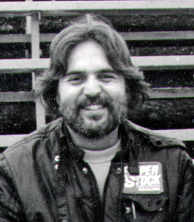|
|
|
|||
 |
||||
 Last month in Indianapolis, I found myself in the unusual position
of actually agreeing with Wally Parks. It isn’t often that yours
truly and NHRA’s founder and board chairman have seen eye to eye.
The simple explanation involves differences in generations and backgrounds. Last month in Indianapolis, I found myself in the unusual position
of actually agreeing with Wally Parks. It isn’t often that yours
truly and NHRA’s founder and board chairman have seen eye to eye.
The simple explanation involves differences in generations and backgrounds.
This is the guy who’d organized the various factions of dry-lakes racers into the Southern California Timing Association (SCTA) way back in 1937 — when my future parents were still in grammar school. A decade later, when Wally was busy organizing the world’s first hot-rod show in Los Angeles, my mom and dad hadn’t yet discovered how two people become moms and dads. By the time I’d blown out the candles on my second birthday cake, Parks had been Hot Rod’s editor for three years and founded the National Hot Rod Association. Like any other two people separated in age by nearly four decades, he and I couldn’t be expected to see things the same way. Equally significant were environmental differences. Although NHRA headquarters and San Fernando Drag Strip were within a half-hour’s drive of each other, Wally and I were operating in parallel universes from 1959 to 1968, when I spent virtually every Sunday spectating at "Fernando." Remember, between 1957 and 1963, the drag-racing world was basically divided into two camps: those tracks that honored the nationwide Fuel Ban, and those that defied NHRA’s gasoline-only edict. As far as NHRA and National Dragster were concerned , any strip that allowed fuel did not exist. This snot-nosed kid didn’t know and couldn’t care less about the politics involved. All I knew was that race cars that burned nitromethane were louder and faster and smoked the tires harder than those running gasoline. I knew this because San Fernando ran both Top Fuel and Top Gas eliminators every Sunday. The notion of traveling across the L.A. Basin to Pomona for the Winternationals never entered my mind until 1963, when Wally temporarily relaxed the ban for a one-time "experiment" with nitro — only to mandate gasoline for NHRA’s only other national event that season, the Nationals. Go figure! Not until the1970s did I learn, from Parks himself, that San Fernando was among the group of Southern California tracks that had banded together in 1957 (following Cook & Bedwell’s unprecedented 167-mph pass) to ban fuel locally, then petition NHRA to adopt their policy nationwide. Among these proponents was C.J. Hart of Santa Ana, who shared the fear that fuel cars were rapidly running out of shutdown room at some strips. During the same lecture, Wally informed me that ’Fernando had been among the first of these SoCal strips to violate this self-imposed policy. Thus, at the height of NHRA’s Fuel Ban, the nitro cars were running every Sunday almost within earshot of Wally’s office. I must admit that the irony of this situation had not been lost on San Fernando’s staff, which included (since 1957) Dave Wallace Sr. Every week in his Drag News report, my dad sang the praises of those wonderful nitro burners. Perhaps coincidentally, neither Dave Wallace was ever offered a writing job by National Dragster, nor by any of the area’s many NHRA-sanctioned promoters. Only after Lions Drag Strip had switched affiliations to AHRA did the opportunity arise for Junior to cover "The Beach" for the weekly drag rags (1968). Similarly, only afer AHRA president Jim Tice had acquired operating rights to Orange County International Raceway in a major 1973 coup that ended NHRA’s long-running sanction was yours truly offered his first opportunity for fulltime employment. In 1975, upon becoming editor of Drag News, I inherited a proud legacy of questioning NHRA policy that predated the Fuel Ban. Two years later, when I jumped to Wally’s alma mater, Hot Rod magazine — a publication that traditionally shared his politics — I was told by spies that someone within NHRA had tried to convince Petersen Publishing Company to reconsider my hiring. Through no intent on my own, I always seemed to wind up on the opposite side of the guardrail from Wally’s organization. (Did I mention that San Fernando never did install guardrails?) Nevertheless, Wally Parks has always been a gentleman. He’s never refused an interview, nor failed to return a call. If he wanted to wring my skinny neck, he never let me know (although he did have a way of squeezing one’s shoulder with those long, strong fingers that emphasized whatever point he was trying to make.) In the course of one interview, he insisted that I slide into the driver’s seat of his hopped-up El Camino — then urged me to see how fast it would go on the Santa Monica Freeway. Another time, he invited my family to a private party at his house, to the obvious astonishment of other NHRA executives present. We’ve also exchanged a number of letters over the last quarter-century (his would typically begin with a line of capital letters, underlined: NOT FOR PUBLICATION!). I really do like this guy. Nobody has more respect for his contributions, nor for his place in motorsports history. Still, to this day, we disagree about almost every subject that comes up. While waiting to board the same plane out of Indianapolis International Airport last month, the subject was downtime. This was two days after Labor Day Monday, during which NHRA had staged one of the greatest fuel shows I’d ever witnessed, with minimal downtime. For this accomplishment, I congratulated Wally and his wife, Barbara, for the entire NHRA team. I also commented on Monday’s sharp contrast to the preceding Top Fuel and AA/Funny Car qualifying sessions, which had been plagued with repeated breakage and downtime on Friday night, Saturday and Sunday. I explained that NHRA’s rolling vacuum cleaners were sucking the life out of national events for me and my friends. I told him that nostaglia-fuel meets were more fun, more compact and more affordable for everyone involved. "Well, what do you think we ought to do?" asked Parks. With some seriousness, I responded that the superior shows produced by modern front-motored fuelers on 12-inch, hard-sidewall M&H tires had gotten me thinking. Unlike today’s NHRA driver, the nostalgia pilot still has options when the tires start to spin. A good slingshot shoe, such as "Wild Bill" Alexander, will smoke the tires from starting line to finish line, if necessary to in a race — without necessarily blowing his 2500-horsepower engine to smithereens. I contrasted the modern NHRA racer. Limited by automatic-timer systems and, too often, a lack of driving ability or experience on slippery tracks, today’s overpowered graduate of Frank Hawley’s Drag Racing School typically cannot or will not "pedal it" in time to avoid disastrous consequences. The results include unendurable downtime, aborted qualifying runs and lousy races. Slow racing is better than no racing, in my opinion. Thus, my semiserious solution for Wally Parks: Either go back to 12.00-16 Racemasters, or take a tip from demolition-derby promoters and moisten the racing surface to prevent excessive traction. That’s right. Just before the fuel cars come up to run, let’s lay down a layer of liquid from the bleach box to the traps, guardwall to guardwall. "Slowing down the cars" would no longer be a continuous challenge for NHRA’s technical department, because the only rules would be those concerning safety. Run what ya brung — and be careful not to bring too much! Overnight, the ever-widening performance advantages enjoyed by the "haves" over the unsponsored "have-nots" would be erased. The drivers with the most talent — not the most money — would return to the top. Active front-motor aces like Alexander, Sammy Hale, Bill Dunlap and "Nitro Neil" Bisciglia would be in great demand. Let’s turn the speed-equipment industry loose on developing new tires, clutches, and other products whose performance is no longer contingent upon optimum traction conditions. If an engine overrevs and explodes, no problem: Just drag a giant magnet down the track to catch the iron pieces; vacuum up the aluminum shrapnel; and fire the next pair! When the fuel cars finish a session or round, send out the Safety Safari to sweep up the oil and prepare the track for wheelstanding sportsman action. In the past, I was among those purists who’d always clamored for ever-quicker e.t.s and ever-faster speeds, I conceded to Parks. Now that I’ve seen how exciting nostalgia racing can be for six seconds, I’m prepared to give up the big numbers in favor of closer racing and reduced downtime. At my age, I don’t want to have to spend 10 to 12 hours in the bleachers. Let’s have a four-hour fuel show on race day, just like the Goodguys, and go home. Ever the politician and gentleman, Wally listened politely to my entire proposal before commenting. (What follows is as close to actual conversation as possible without benefit of a tape recorder or notebook.) "That might be a bit radical, Dave," said Parks in his fatherly way. "But you’re absolutely right about foregoing the big numbers. What I’d like to see us do is prepare the track one time only for the fuel racers, at the beginning of each qualifying session or round of racing. If one of the guys oils the track, well, that’s just too doggone bad for all those who follow. And we’ll put the leakers at the front of the line! Later on, when that round is over, we’ll clean up all the oil. I’d be willing to bet that these teams would get their acts together real quick." I sat speechless, waiting for the grin or chuckle or guffaw that never came. By Gawd, Wally Parks was serious! "After they see how well that works," he continued, "maybe they’ll finally be ready to accept my proposal for eighth-mile racing." "I sure hope not!" I replied. "Wally, I’ll fight ya forever on that one." He laughed; I laughed; we shook hands, promising to stay in touch. I asked for permission to quote him. Permission was granted. This wasn’t the first time in 25 years that we’d boarded the same airplane, but it might’ve been the first time that our thoughts were on the same train, more or less.
Dave Wallace Jr. is a washed-up photojournalist and magazine editor who co-owns Good Communications, Inc. a full-service advertising agency (goodcom@goldrush.com). Wallace also publishes the Hot Rod Nostalgia "magalog" (www.hotrodnostalgia.com). Volume Five of the print version is currently in production.
Photo by Rollo Tomassi
|
||||
|
Copyright 1999-2001, Drag Racing Online and Racing Net Source |
||||
